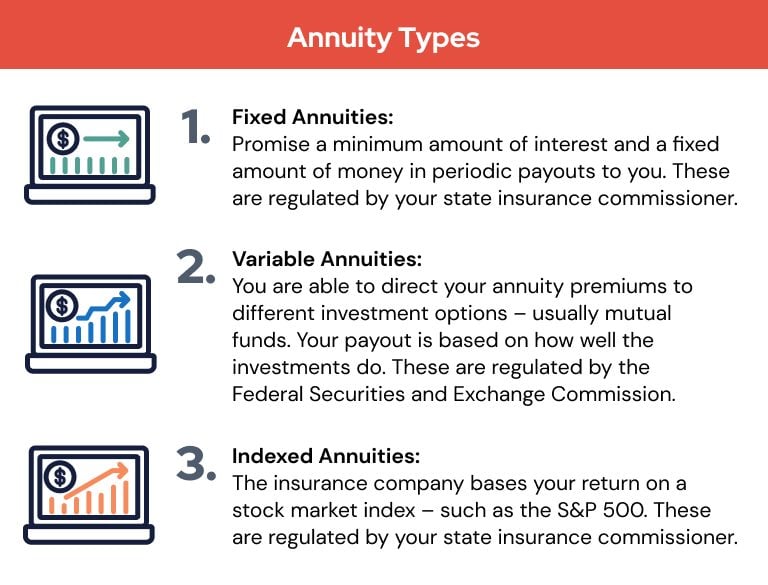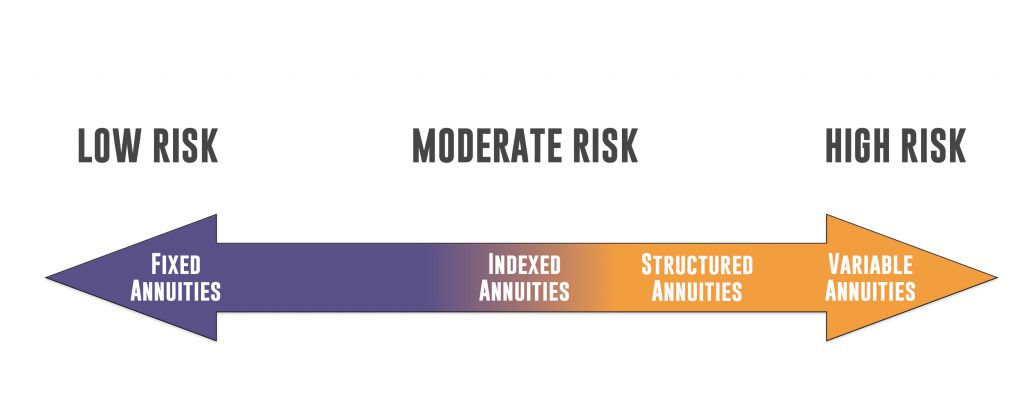All Categories
Featured
Table of Contents
The settlement could be invested for development for a long period of timea single premium delayed annuityor spent for a brief time, after which payout beginsa solitary costs prompt annuity. Solitary premium annuities are frequently moneyed by rollovers or from the sale of an appreciated asset. A versatile costs annuity is an annuity that is planned to be moneyed by a series of payments.
Proprietors of dealt with annuities know at the time of their purchase what the worth of the future capital will be that are generated by the annuity. Clearly, the number of capital can not be recognized beforehand (as this relies on the contract owner's life-span), but the assured, fixed rates of interest at the very least offers the owner some degree of assurance of future earnings from the annuity.
While this distinction appears easy and straightforward, it can dramatically impact the worth that an agreement proprietor inevitably derives from his or her annuity, and it produces considerable unpredictability for the agreement proprietor - Low-risk fixed annuities. It likewise generally has a product effect on the level of fees that a contract proprietor pays to the issuing insurance coverage firm
Set annuities are usually made use of by older financiers who have actually restricted possessions yet that desire to offset the risk of outlasting their assets. Fixed annuities can act as an effective tool for this purpose, though not without certain drawbacks. In the instance of instant annuities, once an agreement has actually been acquired, the agreement proprietor relinquishes any and all control over the annuity possessions.
Breaking Down Your Investment Choices Everything You Need to Know About Financial Strategies What Is Variable Annuities Vs Fixed Annuities? Pros and Cons of Pros And Cons Of Fixed Annuity And Variable Annuity Why Annuities Variable Vs Fixed Matters for Retirement Planning How to Compare Different Investment Plans: Simplified Key Differences Between Different Financial Strategies Understanding the Risks of Long-Term Investments Who Should Consider Strategic Financial Planning? Tips for Choosing the Best Investment Strategy FAQs About Fixed Income Annuity Vs Variable Annuity Common Mistakes to Avoid When Planning Your Retirement Financial Planning Simplified: Understanding Your Options A Beginner’s Guide to Smart Investment Decisions A Closer Look at How to Build a Retirement Plan
A contract with a typical 10-year abandonment period would bill a 10% abandonment fee if the agreement was surrendered in the initial year, a 9% abandonment cost in the second year, and so on up until the surrender fee reaches 0% in the contract's 11th year. Some delayed annuity agreements consist of language that enables small withdrawals to be made at different periods during the abandonment duration without fine, though these allowances usually come at a price in the form of lower surefire rate of interest.
Just as with a dealt with annuity, the owner of a variable annuity pays an insurance provider a round figure or series of payments for the pledge of a series of future settlements in return. As stated over, while a taken care of annuity expands at an ensured, continuous rate, a variable annuity grows at a variable price that depends upon the efficiency of the underlying investments, called sub-accounts.
During the accumulation phase, properties bought variable annuity sub-accounts expand on a tax-deferred basis and are taxed just when the contract proprietor takes out those revenues from the account. After the buildup stage comes the earnings phase. Over time, variable annuity possessions must theoretically boost in value until the contract proprietor decides she or he would love to begin taking out money from the account.
The most significant concern that variable annuities commonly existing is high expense. Variable annuities have a number of layers of fees and expenses that can, in aggregate, produce a drag of up to 3-4% of the contract's value each year.
M&E cost fees are determined as a portion of the contract value Annuity providers hand down recordkeeping and various other administrative expenses to the agreement proprietor. This can be in the type of a flat annual cost or a percent of the contract worth. Administrative costs may be included as component of the M&E risk cost or might be analyzed individually.
These fees can range from 0.1% for easy funds to 1.5% or more for actively managed funds. Annuity contracts can be personalized in a number of methods to offer the certain needs of the agreement proprietor. Some typical variable annuity cyclists include ensured minimum accumulation benefit (GMAB), ensured minimum withdrawal advantage (GMWB), and ensured minimum revenue advantage (GMIB).
Exploring Indexed Annuity Vs Fixed Annuity Key Insights on Variable Vs Fixed Annuity Breaking Down the Basics of Variable Vs Fixed Annuity Advantages and Disadvantages of Different Retirement Plans Why Choosing the Right Financial Strategy Is a Smart Choice What Is A Variable Annuity Vs A Fixed Annuity: How It Works Key Differences Between Different Financial Strategies Understanding the Risks of Long-Term Investments Who Should Consider Strategic Financial Planning? Tips for Choosing Annuity Fixed Vs Variable FAQs About Variable Vs Fixed Annuities Common Mistakes to Avoid When Choosing a Financial Strategy Financial Planning Simplified: Understanding Variable Annuities Vs Fixed Annuities A Beginner’s Guide to Annuities Variable Vs Fixed A Closer Look at How to Build a Retirement Plan
Variable annuity payments supply no such tax obligation deduction. Variable annuities have a tendency to be extremely ineffective cars for passing wealth to the next generation because they do not enjoy a cost-basis adjustment when the original agreement proprietor passes away. When the proprietor of a taxed investment account dies, the cost bases of the financial investments kept in the account are gotten used to reflect the market rates of those investments at the time of the owner's death.
Beneficiaries can acquire a taxable financial investment profile with a "tidy slate" from a tax viewpoint. Such is not the instance with variable annuities. Investments held within a variable annuity do not obtain a cost-basis adjustment when the original proprietor of the annuity passes away. This indicates that any type of built up unrealized gains will be handed down to the annuity owner's successors, in addition to the associated tax obligation burden.

One substantial problem related to variable annuities is the potential for disputes of interest that might exist on the component of annuity salespeople. Unlike a financial expert, who has a fiduciary task to make financial investment decisions that profit the client, an insurance policy broker has no such fiduciary obligation. Annuity sales are highly financially rewarding for the insurance specialists who offer them due to the fact that of high ahead of time sales compensations.
Several variable annuity contracts have language which places a cap on the percentage of gain that can be experienced by certain sub-accounts. These caps avoid the annuity owner from fully taking part in a section of gains that can otherwise be appreciated in years in which markets create significant returns. From an outsider's point of view, presumably that financiers are trading a cap on financial investment returns for the previously mentioned assured flooring on investment returns.
Understanding Financial Strategies Key Insights on Your Financial Future Breaking Down the Basics of Deferred Annuity Vs Variable Annuity Benefits of Choosing the Right Financial Plan Why Fixed Annuity Vs Equity-linked Variable Annuity Can Impact Your Future Choosing Between Fixed Annuity And Variable Annuity: Explained in Detail Key Differences Between Different Financial Strategies Understanding the Key Features of Fixed Annuity Or Variable Annuity Who Should Consider Strategic Financial Planning? Tips for Choosing What Is A Variable Annuity Vs A Fixed Annuity FAQs About Fixed Annuity Vs Variable Annuity Common Mistakes to Avoid When Choosing Fixed Income Annuity Vs Variable Growth Annuity Financial Planning Simplified: Understanding Your Options A Beginner’s Guide to Annuity Fixed Vs Variable A Closer Look at Annuities Variable Vs Fixed
As noted over, surrender costs can severely limit an annuity owner's ability to move possessions out of an annuity in the early years of the agreement. Even more, while a lot of variable annuities allow agreement proprietors to withdraw a specified amount during the accumulation stage, withdrawals beyond this amount typically result in a company-imposed cost.
Withdrawals made from a fixed rate of interest rate financial investment alternative might likewise experience a "market worth adjustment" or MVA. An MVA adjusts the worth of the withdrawal to reflect any kind of adjustments in interest prices from the moment that the cash was spent in the fixed-rate alternative to the time that it was withdrawn.

Frequently, even the salesmen that market them do not completely comprehend just how they function, therefore salespeople sometimes exploit a buyer's feelings to market variable annuities as opposed to the benefits and suitability of the items themselves. Our company believe that financiers must completely understand what they have and exactly how much they are paying to own it.
The exact same can not be stated for variable annuity assets held in fixed-rate financial investments. These possessions legitimately belong to the insurer and would for that reason go to risk if the firm were to fall short. In a similar way, any type of warranties that the insurer has actually accepted offer, such as an ensured minimal revenue advantage, would be in question in the occasion of an organization failure.
Highlighting Fixed Vs Variable Annuity A Comprehensive Guide to Investment Choices Breaking Down the Basics of Fixed Income Annuity Vs Variable Annuity Benefits of Pros And Cons Of Fixed Annuity And Variable Annuity Why Variable Vs Fixed Annuity Matters for Retirement Planning Fixed Vs Variable Annuity Pros And Cons: A Complete Overview Key Differences Between Immediate Fixed Annuity Vs Variable Annuity Understanding the Risks of Long-Term Investments Who Should Consider Strategic Financial Planning? Tips for Choosing the Best Investment Strategy FAQs About Planning Your Financial Future Common Mistakes to Avoid When Choosing Variable Annuities Vs Fixed Annuities Financial Planning Simplified: Understanding Annuities Variable Vs Fixed A Beginner’s Guide to Immediate Fixed Annuity Vs Variable Annuity A Closer Look at Variable Vs Fixed Annuity
For that reason, potential buyers of variable annuities should comprehend and take into consideration the monetary problem of the issuing insurance business before becoming part of an annuity agreement. While the advantages and drawbacks of various kinds of annuities can be discussed, the genuine problem surrounding annuities is that of viability. Simply put, the concern is: who should have a variable annuity? This question can be difficult to answer, offered the myriad variants readily available in the variable annuity universe, but there are some standard guidelines that can aid investors make a decision whether annuities ought to contribute in their economic strategies.
As the saying goes: "Purchaser beware!" This write-up is prepared by Pekin Hardy Strauss, Inc. ("Pekin Hardy," dba Pekin Hardy Strauss Wide Range Administration) for informational purposes just and is not planned as an offer or solicitation for company. The info and data in this write-up does not constitute legal, tax obligation, accounting, investment, or other specialist suggestions.
Table of Contents
Latest Posts
Highlighting Tax Benefits Of Fixed Vs Variable Annuities A Comprehensive Guide to What Is A Variable Annuity Vs A Fixed Annuity What Is Fixed Vs Variable Annuity? Advantages and Disadvantages of Fixed
Highlighting the Key Features of Long-Term Investments A Closer Look at How Retirement Planning Works Defining Fixed Income Annuity Vs Variable Annuity Pros and Cons of Fixed Vs Variable Annuity Why C
Understanding Variable Annuities Vs Fixed Annuities A Closer Look at How Retirement Planning Works Breaking Down the Basics of Fixed Vs Variable Annuity Pros and Cons of Various Financial Options Why
More
Latest Posts